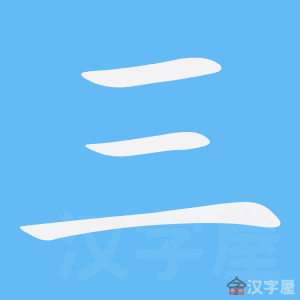|
三合院
sān hé yuàn
|
residence consisting of structures surrounding a courtyard on three sides
|
|
三味线
sān wèi xiàn
|
shamisen, three-stringed Japanese musical instrument
|
|
三味線
sān wèi xiàn
|
shamisen, three-stringed Japanese musical instrument
|
|
三和弦
sān hé xián
|
triad;
musical chord of three notes, such as major triad do-mi-so
|
|
三國
sān guó
|
Three Kingdoms period (220-280) in Chinese history;
several Three Kingdoms periods in Korean history, esp. from 1st century AD to unification under Silla 新羅|新罗[Xin1 luo2] in 658
|
|
三国史记
sān guó shǐ jì
|
History of Three Kingdoms (Korean: Samguk Sagi), the oldest extant Korean history, compiled under Kim Busik 金富軾|金富轼[Jin1 Fu4 shi4] in 1145. The three kingdoms are Goguryeo 高句麗|高句丽[Gao1 gou1 li2], Baekje 百濟|百济[Bai3 ji4], Silla 新羅|新罗[Xin1 luo2].
|
|
三國史記
sān guó shǐ jì
|
History of Three Kingdoms (Korean: Samguk Sagi), the oldest extant Korean history, compiled under Kim Busik 金富軾|金富轼[Jin1 Fu4 shi4] in 1145. The three kingdoms are Goguryeo 高句麗|高句丽[Gao1 gou1 li2], Baekje 百濟|百济[Bai3 ji4], Silla 新羅|新罗[Xin1 luo2].
|
|
三国志
sān guó zhì
|
History of the Three Kingdoms, fourth of the 24 dynastic histories 二十四史[Er4 shi2 si4 Shi3], composed by Chen Shou 陳壽|陈寿[Chen2 Shou4] in 289 during Jin Dynasty 晉朝|晋朝[Jin4 chao2], 65 scrolls
|
|
三國志
sān guó zhì
|
History of the Three Kingdoms, fourth of the 24 dynastic histories 二十四史[Er4 shi2 si4 Shi3], composed by Chen Shou 陳壽|陈寿[Chen2 Shou4] in 289 during Jin Dynasty 晉朝|晋朝[Jin4 chao2], 65 scrolls
|
|
三國演義
sān guó yǎn yì
|
Romance of the Three Kingdoms by Luo Guanzhong 羅貫中|罗贯中[Luo2 Guan4 zhong1], one of the Four Classic Novels of Chinese literature;
a fictional account of the Three Kingdoms at the break-up of the Han around 200 AD, consistently portraying Liu Bei's Shu Han 劉備|刘备, 蜀漢|蜀汉 as virtuous heroes and Cao Cao's Wei 曹操, 魏 as tyrannical villains
|
|
三围
sān wéi
|
BWH, abbr. for a woman's three measurements, namely: bust 胸圍|胸围[xiong1 wei2], waist 腰圍|腰围[yao1 wei2] and hip 臀圍|臀围[tun2 wei2]
|
|
三圍
sān wéi
|
BWH, abbr. for a woman's three measurements, namely: bust 胸圍|胸围[xiong1 wei2], waist 腰圍|腰围[yao1 wei2] and hip 臀圍|臀围[tun2 wei2]
|
|
三地门
sān dì mén
|
Santimen township in Pingtung County 屏東縣|屏东县[Ping2 dong1 Xian4], Taiwan
|
|
三地門
sān dì mén
|
Santimen township in Pingtung County 屏東縣|屏东县[Ping2 dong1 Xian4], Taiwan
|
|
三地门乡
sān dì mén xiāng
|
Santimen township in Pingtung County 屏東縣|屏东县[Ping2 dong1 Xian4], Taiwan
|
|
三地門鄉
sān dì mén xiāng
|
Santimen township in Pingtung County 屏東縣|屏东县[Ping2 dong1 Xian4], Taiwan
|
|
三大纪律八项注意
sān dà jì lǜ bā xiàng zhù yì
|
the Three Rules of Discipline and Eight Points for Attention, a military doctrine issued in 1928 by Mao Zedong for the Red Army, which included a number of injunctions demanding high standards of behavior and respect for civilians during wartime
|
|
三大紀律八項注意
sān dà jì lǜ bā xiàng zhù yì
|
the Three Rules of Discipline and Eight Points for Attention, a military doctrine issued in 1928 by Mao Zedong for the Red Army, which included a number of injunctions demanding high standards of behavior and respect for civilians during wartime
|
|
三天不打,上房揭瓦
sān tiān bù dǎ , shàng fáng jiē wǎ
|
three days without a beating, and a child will scale the roof to rip the tiles (idiom);
spare the rod, spoil the child
|
|
三天兩頭
sān tiān liǎng tóu
|
lit. twice every three days (idiom); practically every day;
frequently
|
|
三天打鱼,两天晒网
sān tiān dǎ yú , liǎng tiān shài wǎng
|
lit. to fish for three days and sun-dry the nets for two days (proverb);
fig. not to persevere in doing sth;
to do sth by fits and starts
|
|
三天打魚,兩天曬網
sān tiān dǎ yú , liǎng tiān shài wǎng
|
lit. to fish for three days and sun-dry the nets for two days (proverb);
fig. not to persevere in doing sth;
to do sth by fits and starts
|
|
三夷教
sān yí jiào
|
the three foreign religions (Nestorianism, Manicheanism and Zoroastrianism)
|
|
三姑六婆
sān gū liù pó
|
women with disreputable or illegal professions (idiom)
|
|
三字经
sān zì jīng
|
Three Character Classic, 13th century reading primer consisting of Confucian tenets in lines of 3 characters;
(slang) swearword;
four-letter word
|

